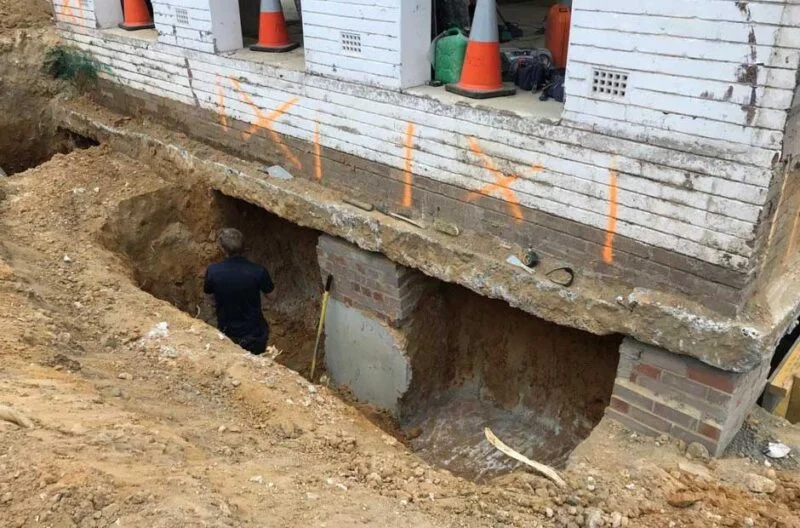
If your house or building’s foundation needs reinforcement, there are various underpinning methods available to you, notes Vineyard, a professional property management company – some more costly than others – which help transfer its load onto deeper soil strata that are better equipped to support it.
Underpinning is the practice of digging around the foundation and pouring large volumes of concrete below it, often called pit or mass underpinning. Burlington underpinning vs benching and other types of underpinning should be considered when there are issues with settling or cracking due to soil that is too loose or inadequate to support the structure.
Expansion Piles
Piles can be an efficient means of shifting loads away from a building’s foundation and into more secure soil layers, where load transference occurs more effectively. To be effective, the soil underpinning the pile must be strong and below what’s known as an “active soil layer”, which may change with seasonal changes in moisture content levels.
One cost-effective method for underpinning foundations is using expansion piles – steel piles which expand when loaded – which creates friction with soil to raise and stabilize foundations. Expanded concrete piles differ from their concrete counterparts by shifting load across their full length rather than depending on soil friction alone for support, thus helping minimize lateral force on foundation walls and decrease soil pore pressure. This can also help minimize foundation wall lateral force as well as decrease soil pressure levels in general. Comparison of force chain distribution laws at four distinct loading stages shows that the distribution range for large principal stress vectors becomes denser and elliptical in foundation soil, while its concentration zone around the bottom surface of piles reaches convex arch shape.
Stumps
Stumps are the remnants of dead trees, and can take up valuable space that could otherwise be used for gardens or seating areas. Furthermore, they pose a tripping hazard for children and pets, potentially becoming dangerous objects that need professional removal services to get rid of.
The term stump can also be used figuratively to refer to a platform from which political campaigns deliver speeches; this usage can often be found at campaign rallies.
Foundation underpinning involves strengthening existing foundations of buildings or homes. This process may be achieved in several ways, such as using piers or micropiles; expanding foundation depth or breadth so it rests on different soil layers or distributes its load over a wider area; chemical treatments to consolidate foundation soil – also known as mass concrete underpinning – or by expanding into new layers with mass concrete underpinning techniques.
Piers
A pier foundation is an underpinning foundation that transfers load from your house onto steel or concrete pillars that extend down into solid bedrock, offering added support to heavy structures as well as areas with hard, firm soil above softer clay soils which is typical for residential environments.
There are various kinds of piers. Concrete piers involve drilling a cylindrical hole down to your desired depth and filling it with concrete, while drilled caissons, which consist of reinforced concrete hollow sections with an expanded bottom, are another choice.
Foundation piers work to lift your house off weak soil by lifting its weight beyond it and lifting back to its original level, stabilizing against future movement that could damage or cause other costly structural issues in your home or cause costly maintenance bills. They can also prevent excavation of any future repairs needed due to soil displacement due to construction activities as well as reduce ground vibration for easier electrician and plumber maintenance access. Other advantages include reduced excavation efforts required as minimal disruption is caused to soil environments while vibration levels decrease as well as easier access for maintenance services like electricians and plumbers for maintenance maintenance work as maintenance access by electricians and plumbers for maintenance services and more maintenance professionals as possible.
Jacketing
Jacketing is a method used to increase the strength of structural columns. This technique is especially helpful when load on a column has increased or damage has occurred due to use, weathering or poor construction practices.
Reinforced concrete is the most suitable material to construct a jacket, as this increases ductility, shear, flexural and displacement capacities of structures while simultaneously increasing displacement capacity of structural columns.
Underpinning by pile driving may be more costly, but it provides excellent stability at an economical cost. Furthermore, this underpinning technique is relatively quick compared to others and may provide the solution to houses experiencing creep or slope failure due to factors like soil expansion, large trees nearby removing moisture from the soil which causes shrinkage or damaged plumbing that hasn’t yet been repaired.

